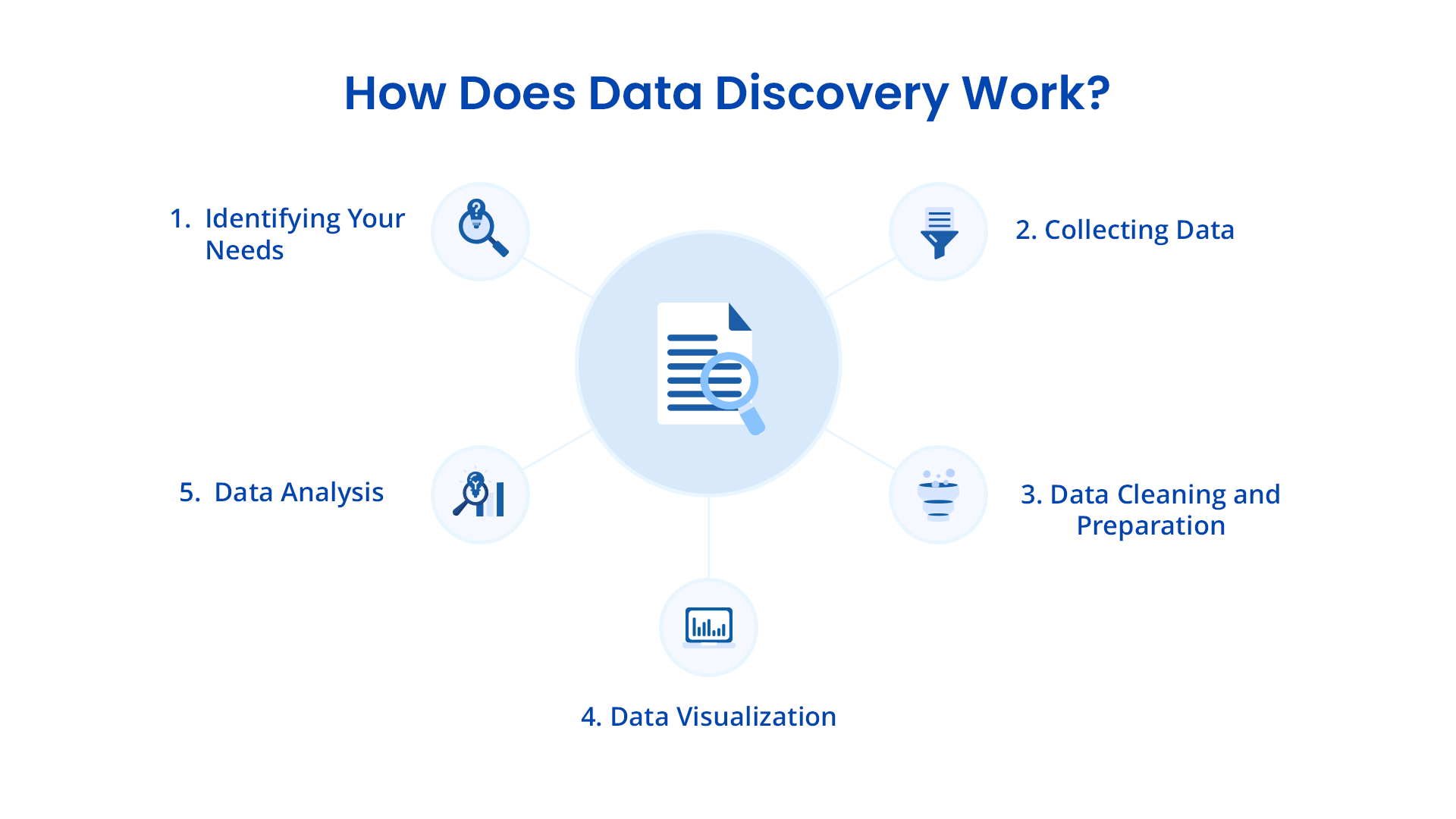
What is Data Discovery? Methods, Benefits, and Best Practices
Your organization is likely sitting atop vast quantities of diverse data. However, all that data must undergo certain processes before you can fully leverage it. Data discovery is among those processes.
Let’s learn more about it.
What is Data Discovery?
Data discovery is understanding relationships between entities, identifying patterns and outliers, and gaining insights from relevant data. This process relies primarily on exploration and analysis.
Data discovery is an iterative process that involves repeatedly refining and improving one’s understanding of the data. Its execution can vary depending on the industry and business requirements, as differences in data types, regulatory considerations, and objectives result.
For example, the healthcare sector primarily works with patient data, clinical trial findings, and electronic health records during information discovery, aiming to optimize resource use or improve patient outcomes. Marketing teams will use data discovery to focus on social media data, CRM data, and web analytics to optimize marketing strategies and maximize ROI.
Why is Data Discovery Important?
Today, nearly every organizational interaction results in data generation. Whether dealing with customers, suppliers, employees, or other stakeholders, your business steadily generates data daily.
All this data can provide valuable insights into your operations and help you identify room for improvement. But to obtain these insights, you must first sift through all the different kinds of data. That makes data discovery so important — it enables you to explore your data and comb through it in a structured and systematic way.
Ultimately, it helps you make sense of your data while enabling its proper utilization.
Categories of Data Discovery
Data discovery can be broken down into the following categories:
1. Data Preparation
Data preparation is also known as data preprocessing. At this stage, statistical techniques help merge raw data from various sources. The data then undergoes cleaning and transformations to improve quality and ensure consistent formatting.
2. Data Visualization
Visualization makes it much easier to spot relationships and patterns in data. Compared to poring over spreadsheets and raw figures, data visualization saves time. It simplifies complex data.
3. Advanced Analytics and Reporting
At this stage, data scientists use descriptive statistics to summarize the data and create a simple report to aid business users and other non-technical stakeholders in decision-making. Factors such as the dataset’s frequency distribution, variability, and central tendency are highlighted.

Types of Data Discovery
As noted earlier, data discovery can be highly subjective. There are different approaches to achieving the same goal, but the two most common types of data discovery are:
1. Manual Data Discovery
As its name indicates, this type of discovery is human-driven. This was the only possible approach before the rapid development of Artificial Intelligence (AI) and Machine Learning (ML) techniques.
Manual data discovery uses the knowledge and expertise of an individual proficient in data management who performs all the required processes by hand.
2. Smart Data Discovery
Smart data discovery uses modern techniques and technologies to accelerate the discovery process. Dedicated AI/ML tools can automate every step of data discovery, from data collection to analysis and reporting.
Smart data discovery is quicker and more accurate. It also leaves little room for human error, making it preferable to its manual counterpart.
How Does Data Discovery Work?
Here’s a closer look at each step of the data discovery process:
Step 1: Identifying Your Needs
A clearly defined goal can guide your subsequent steps and refine your approach to data discovery. It’s also important to consider the questions you want your data to answer. Do you need to gather insights into customer behavior, or have you identified an opportunity to improve your marketing campaigns but need specific data to validate it? Either way, having a well-defined goal is necessary to guide your data exploration.
Step 2: Collecting Data
A single data source only provides a limited perspective and incomplete information, so collating disparate sources is essential. Integrating multiple data sources gives you the holistic overview you need for successful data discovery.
Step 3: Data Cleaning and Preparation
Data cleaning and preparation are crucial to obtaining a unified view of the data. These processes keep the data from having varying formats, containing unnecessary or irrelevant information, or featuring null or incorrect values that can skew your analysis.
Step 4: Data Visualization
After the data is cleaned and prepared, it needs to be visualized to make it easier to understand. Data visualization tools such as graphs, charts, diagrams, and maps make data more comprehensible so everyone can benefit from it.
Step 5: Data Analysis
Visualization prepares the data for in-depth analysis. This stage connects data discovery’s findings and insights with strategy and implementation. Drawing on the results of the discovery process, data analysis helps you understand what your business data is trying to tell you so you can act on it.
Constant Iteration
Beyond these five steps, it’s worth noting that data discovery is an iterative process. Businesses continue to generate data, so they need consistent procedures that continue building on previous findings. While this requires effort, it also helps ensure you’re always using your data, i.e., using it to drive growth and improvement.

What are the Benefits of Data Discovery?
- It enables you to identify patterns, anomalies, and areas for improvement. Correcting these inaccuracies improves data integrity.
- It supports decision-making by providing real-time insights. This allows you to strategize more effectively and course-correct as needed on an organizational level.
- It can identify and mitigate operational inefficiencies, boosting productivity and ensuring better resource utilization.
- It helps you determine if your business is using data responsibly. By enforcing your data governance framework, you can avoid regulatory and compliance issues.
- Increased data accessibility promotes a data-driven culture within your organization, creating a more informed workforce.
End-to-End Data Management At Its Easiest
Astera streamlines your data management with its zero-code operations and intuitive interface. Get started today!
Download Your FREE TrialData Discovery Use Cases
- Healthcare: Healthcare facilities analyze patient data to streamline diagnostic processes, develop more effective treatment plans, and improve outcomes.
- Finance: Financial institutions can use data discovery to monitor transactions. Checking for suspicious or irregular activities helps reduce the risk of fraud.
- Retail: Data discovery enables businesses in the retail sector to understand customer behavior and optimize their inventory management accordingly. Sales data analysis reveals trends these businesses use to adjust their inventory levels — striking a balance between customer demand and optimum stock levels.
- Marketing: Marketers use data discovery to segment their target audience based on age, preferences, and behavior. Such findings help them create more personalized campaigns with the appropriate messaging.
- Insurance: Data discovery in the insurance sector allows service providers to analyze customer claims data and find patterns. This improves risk assessment and allows insurance companies to minimize instances of insurance fraud.
- Life Sciences: Life sciences organizations can collate and analyze clinical trial results, studies, and research. Data discovery in this sector can contribute to accelerated medical R&D, drug discovery, and healthcare advancements.
- Manufacturing: By using data discovery to analyze sensor and machine data, manufacturers can look for potential issues or indicators of decreased performance. This information allows them to adjust their maintenance schedules to avoid disruptions.
- Telecommunications: Network data analysis enables telecom companies to find areas of congestion, implement corrective measures, and offer faster and more reliable services to their customers.
- Energy: Energy companies analyze weather information and energy consumption to fine-tune their production processes based on the demand. This helps them lower production costs and improve sustainability.
Data Discovery Best Practices
1. Establish Objectives
The clearer your goals, the easier it is to work towards achieving them. When working with specific objectives, your analysis will be more targeted and result in relevant insights.
2. Prioritize Data Governance
A comprehensive data governance framework can ensure the availability of high-quality and accurate data. Data governance rules and policies also keep your workforce abreast of their responsibilities. These rules contribute to a more streamlined data discovery process by clearly outlining the roles of the personnel involved.
3. Collaboration and Coordination
Data discovery works best as a cross-function initiative instead of an isolated effort.
Data teams will perform the actual work, but you also need input from other — often non-technical — stakeholders. This exchange of diverse perspectives and expertise promotes collaboration. It’s the surest way to ensure the derived insights align with your organizational strategy.
4. Training and Development
Provide your workforce with the necessary resources to hone its data literacy skills. Conduct training programs to give your employees a solid understanding of tools and knowledge of how to interpret the findings they obtain. Employees also benefit from knowing how to implement data-driven insights into their decisions.
5. Evaluation and Improvement
Leverage data discovery’s iterative nature by monitoring its efficacy each cycle. Assess which components are working and which aren’t, and make the necessary corrections to refine your data discovery methods continuously.
6. Advanced Tools and Automation
Automation is an effective solution for dealing with growing data volumes. Automated data tools make discovery more efficient through AI and machine learning algorithms. They offer real-time analytics and interactive visualization features that improve data discovery’s effectiveness and actionability.
What are Data Discovery Tools and How Do They Help Businesses?
Data discovery tools are dedicated software applications that facilitate discovering data. These tools help businesses in the following ways:
- Streamlining Data Analysis: They simplify data collection, preparation, and analysis through automation. They make it easier for analysts to focus on deriving insights instead of the nitty-gritty of these processes.
- Enhancing Visualization: They allow users to quickly create dynamic, in-depth visual representations of data, making it easier for users to identify patterns and trends.
- Improving Accessibility: These tools make data more accessible to users with varying technical proficiency. Their intuitive, user-friendly interfaces allow employees to explore data without specialized knowledge.
- Driving Innovation: Data discovery tools allow your organization to adapt to new data sources and analytical methods. You can readily integrate new data sources and apply advanced analytics techniques so that each iteration builds on the preceding ones.
- Integration with Existing Systems: You can integrate data discovery tools seamlessly with other business systems — such as ERP and CRM systems — to obtain a unified view of data across your organization.
- Scalability: These tools’ scalability delivers reliable performance even as your organization grows, works with increased quantities of data, and its data management needs evolve.
Summing It Up
Data discovery is a valuable part of your overall data management strategy. It helps you find and understand the insights big data offers so you can practice data-driven decision-making and create a data-centric culture.
As an enterprise-grade, all-in-one data management solution, Astera allows you to extract, integrate, prepare, and transform data and then export it to various BI tools for convenient visualization. Download a free 14-day trial, or speak to our team today for more information.



